Book contents
- Frontmatter
- Dedication
- Contents
- List of Illustrations
- List of Contributors
- Acknowledgements
- List of Abbreviations
- Introduction
- 1 Biography and Context
- 2 The Calderonian World
- 3 The Playwright’s Craft: Calderón and the Great Theatrical World of Early Modern Spain
- 4 La vida es sueño
- 5 The Honour Plays of Calderón
- 6 Calderón, the Comedian
- 7 Mythological Court Spectacle Plays
- 8 Religious comedias
- 9 Calderón’s ‘Sacramental, Allegorical and Historical’ autos
- 10 Calderón’s graciosos
- 11 Calderón and Visual Art
- 12 The Staging of Calderón’s Theatre
- 13 Calderón’s European Reception from Romanticism to the Twentieth Century
- 14 The Reception of Calderón in the Hispanic World
- Appendices
- Consolidated Bibliography
- Index
- Tamesis • Companions
II - Versification in Calderón
Published online by Cambridge University Press: 07 October 2022
- Frontmatter
- Dedication
- Contents
- List of Illustrations
- List of Contributors
- Acknowledgements
- List of Abbreviations
- Introduction
- 1 Biography and Context
- 2 The Calderonian World
- 3 The Playwright’s Craft: Calderón and the Great Theatrical World of Early Modern Spain
- 4 La vida es sueño
- 5 The Honour Plays of Calderón
- 6 Calderón, the Comedian
- 7 Mythological Court Spectacle Plays
- 8 Religious comedias
- 9 Calderón’s ‘Sacramental, Allegorical and Historical’ autos
- 10 Calderón’s graciosos
- 11 Calderón and Visual Art
- 12 The Staging of Calderón’s Theatre
- 13 Calderón’s European Reception from Romanticism to the Twentieth Century
- 14 The Reception of Calderón in the Hispanic World
- Appendices
- Consolidated Bibliography
- Index
- Tamesis • Companions
Summary
The fact that Golden Age drama is written in verse is the first thing that a student will notice when beginning to read a play from the period. However, versification is the least discussed of the important aspects of the comedia nueva. Poetic drama has not been in fashion for some time and can seem daunting to a new reader, especially when it is polymetric (i.e. using a variety of verse forms) and clearly lacks the uniformity of appearance of French classical and Shakespearean drama. Its polymetry has probably acted as an obstacle to the performance of Golden Age theatre both in Spain, where uncertainty about how to speak the verse has been evident, and in other countries, where verse acts as an impediment to translators.
In fact, once the few rules outlined below have been digested, it is not difficult, even for an inexperienced reader, to tell verse forms apart on the page. What is harder to recover is the Golden Age audience's apparent ability to hear changes in metre and form and thus be sensitive to the shifts of mood and other subtleties that came with them. Verse forms often changed with the end of a salida or ‘scene’, that is after the stage had briefly emptied, or with a change in the status or objective of the speaker, or in the mood of the dialogue. They do not always have the same functions, and as fashions and personal predilections changed so different dramatists favoured different forms at different times, to the extent that many of Lope de Vega's plays have been fairly reliably dated by the preponderance of certain types of verse within them. Calderon had his own preferences and habits when composing the verses of his plays, some shared with the other playwrights of the generation that followed Lope.
Inevitably, the starting place for the discussion of this issue is Lope's poetic ‘defence’ of his new kind of theatre, the Arte nuevo de hacer comedias en este tiempo of 1609, in which the following lines of advice occur:
- Type
- Chapter
- Information
- A Companion to Calderón de la Barca , pp. 324 - 334Publisher: Boydell & BrewerPrint publication year: 2021

